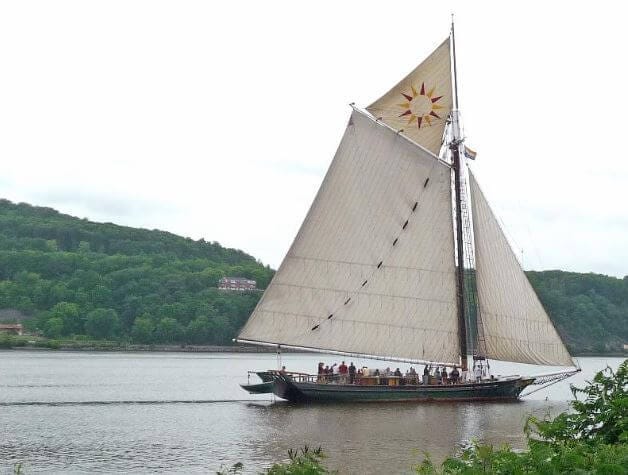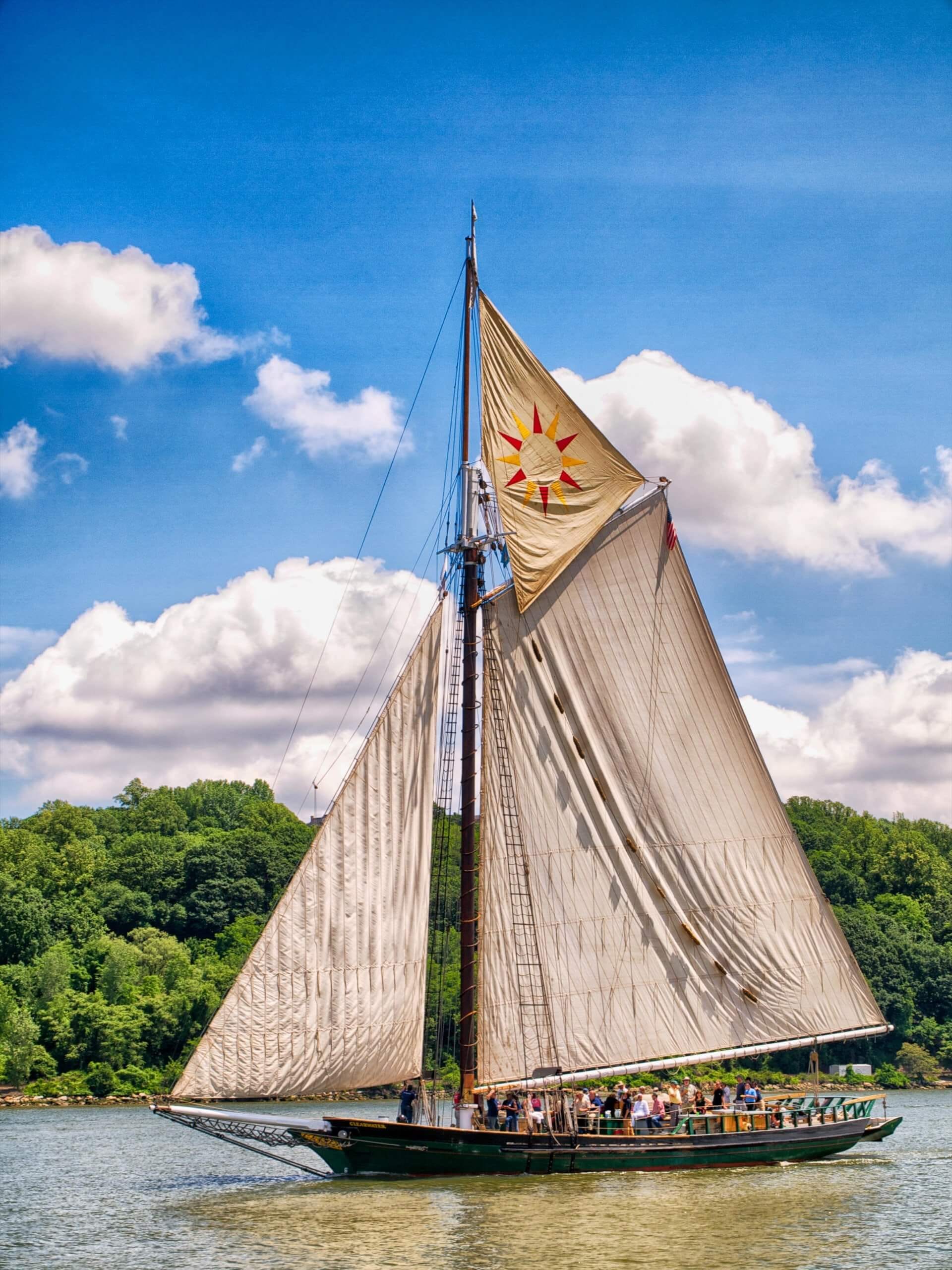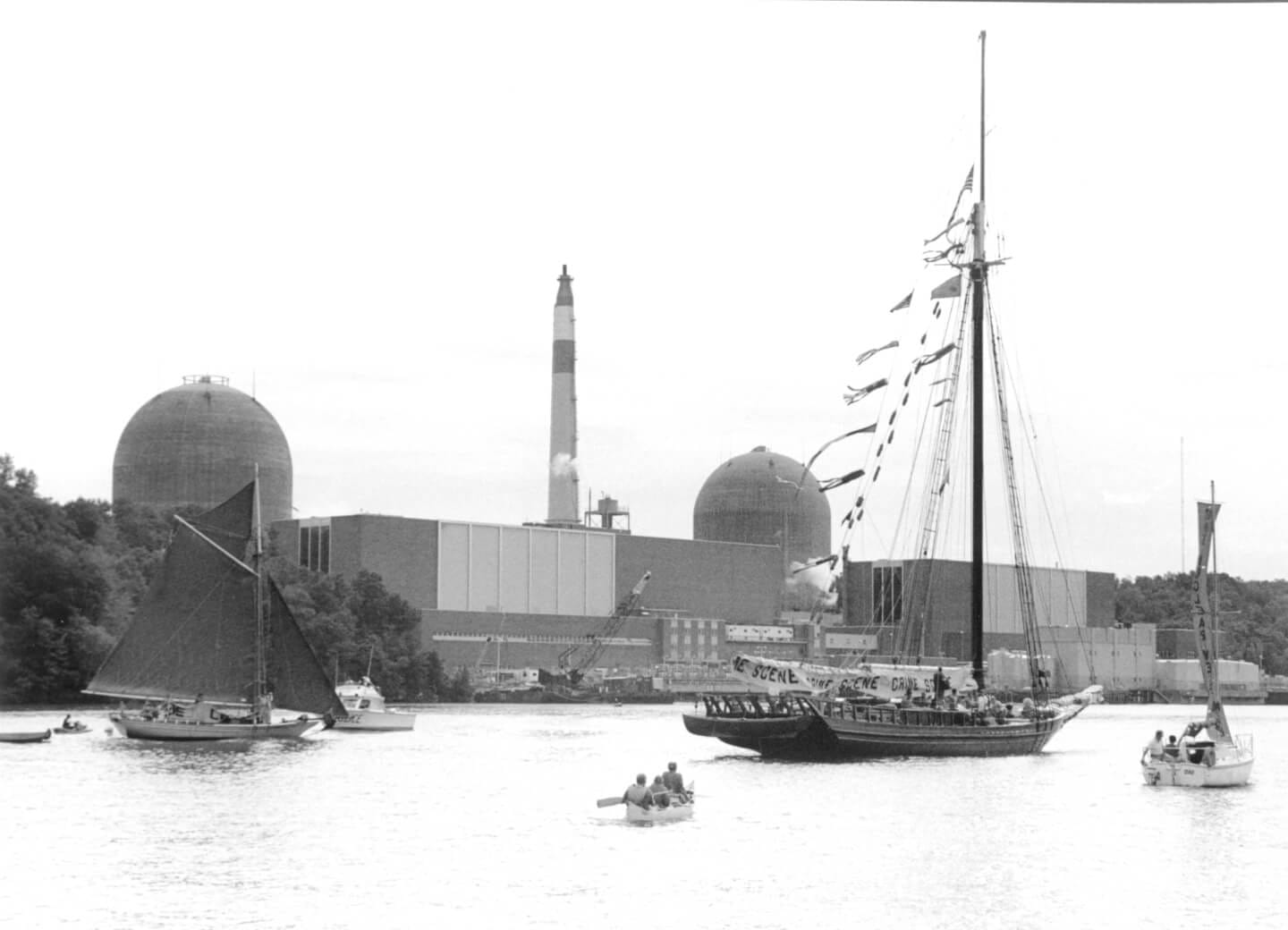Sloop Clearwater
For over 50 years, the Sloop Clearwater has sailed the Hudson River, building awareness and advocating for the region's precious environment.

Hello! Who are you? Tell us about yourself. What are you passionate about? What do you enjoy doing?
I’m the Hudson River Sloop Clearwater, a 51 year old replica of sailboats common on the river back in the 19th century. The Hudson was the New York Thruway then, and my ancestors were the 18 wheelers of that time. Today my cargo is people — thousands each year, mostly schoolchildren, who gain a new appreciation for the river from my decks. I love the look of determination on their faces as they pull up my three thousand pounds of sail and spar or shout in amazement as my nets reveal the catch of the day — “A crab! An eel! A STURGEON!” — all carefully released after being introduced to the kids.

How did you discover the Hudson Valley?
My ancestors came over with the Dutch — they used sloops back in Holland and adapted the design to conditions on the Hudson. But myself, I came to the Hudson Valley in 1969 thanks to the imagination of Pete Seeger. The river was a mess then, and he believed that a big beautiful boat could bring people down to the Hudson and help them learn to love their river again.

Walk us through a typical day.
What’s typical changes according to the season, but I’m busiest in spring when schools send their students to me. The first order of business each day is a salt-water bath. My crew pours brine over my decks and brushes it in – keeps my planks and frames from rotting. A yellow school bus will arrive around 9; the kids come aboard and off we go on a three hour sail. They will set and pull back my net, haul up my mainsail, push and pull on my 10-foot long tiller, and visit learning stations to explore the ecology of the Hudson. Just when pounding feet and the din of eager voices get a bit overwhelming, everyone goes silent for a few moments to listen while I rock to the music the breeze makes in my rigging, with harmonies from the water passing along my hull and solos from the gulls flying by. Soon afterwards it’s back to the dock for a lunchtime snooze, followed by another three hour sail. Once that’s done the crew pretties me up, furling my sails just so and doing some of the many maintenance tasks that keep me looking and feeling good for my 51 years. And if I’m lucky in the evening, some of my crew will sing me to sleep.
Where do you do your best creative work?
I’d have to say during my sails through the Hudson Highlands from Newburgh Bay past West Point and Bear Mountain to Peekskill Bay. The winds there can pull some real surprises, roaring through the gap between Storm King and Breakneck Ridge or bouncing off the mountain slopes and coming at you from unexpected directions. There’s a nasty S-curve right at World’s End, the deepest spot in the whole river, that requires careful sailing, and rocky reefs to watch out for, not to mention the tidal currents and eddies that push and pull me this way and that. Yep, I need to be creative in dancing through that passage.
How has the Hudson Valley influenced or impacted your creative work?
My design is specifically influenced by Hudson Valley weather and topography and by the river itself. My fore and aft sloop rig — a single mast with a jib set in front of the mast and a mainsail behind — is really handy; I can maneuver easily in tight quarters like the narrow river channel approaching Albany. And what a mainsail — 3,000 square feet of sail, one of the largest single pieces of sail on the Atlantic Coast. That huge area of sail is great for catching the often gentle breezes of summer months on the river, and my mast — towering 108 feet over the water — lets me reach high with a topsail to catch light airs that might not make it down to river level. My hull is broad but not very deep; to keep me from being pushed sideways when the wind is abeam I have a centerboard instead of a deep keel. I can lower that centerboard like a fin to keep me tracking straight ahead or pull it up when entering shoal water. With the centerboard up I need only about seven feet of water to float safely above the bottom, allowing me to visit docks in the shallows common along the Hudson riverfront. When at docks, my low freeboard — the height of my deck over the water — makes it easy to load and unload cargo and board passengers. While my design is great for sailing the Hudson, I get very nervous about heading out on the ocean; my rig and hull are not suited for the winds and waves out there.

What’s surprised you most about living and working in the Hudson Valley? What’s been challenging?
When I first arrived I was appalled at the condition of the Hudson. Back then Governor Rockefeller called the section at Albany “one great septic tank.” I was really surprised that folks allowed it to become so polluted. That’s changed, and I’m proud of my role in making the Hudson cleaner and healthier. But it still surprises me that people who have lived in the Hudson Valley for many years know so little about the river that gives this region its name. And I worry about complacency. People generally realize that the river is cleaner, but aren’t aware that threats remain: PCBs left in place after GE’s cleanup, aging sewage treatment infrastructure and overflows, and sea-level rise due to climate change. That last challenge is huge. Many people don’t realize that — as an arm of the sea, an estuary, as far as Troy — the Hudson is pretty much at sea level. Over the twentieth century, sea level at the Battery in Manhattan rose a full foot, and since then sea level there has been rising at a faster rate. That rise in sea level is felt up the Hudson. That means that in the future it won’t take a storm as powerful as Irene or Sandy to wreak havoc along the river. And that said, scientists have recently shown that — as predicted — global warming has made hurricanes stronger.
What do you hope to see for the Hudson Valley in the next five years?
I’m encouraged by actions taken in communities like Kingston, my home port. After Irene and Sandy caused severe flooding in the Rondout District there, the city became a Climate Smart Community and established an action plan to address ways of adapting to climate change. Kingston is not alone; dozens more Hudson Valley communities realize that climate change is real and happening now, and are taking action to adapt to change and reduce their carbon footprint. I also see hope in the $3 billion Restore Mother Nature Bond Act, the largest environmental bond act in State history, that will go before voters this fall. Given historically low interest rates and an urgent need to invest in our infrastructure, it could give a big boost to the fight against climate change.

Are you part of any local groups or communities you’d like to mention?
I wouldn’t be able to fulfill my role as the “flagship of the environmental movement” if it weren’t for the thousands of Clearwater members here in the valley and further away that keep me sailing. Their financial contributions are essential, but their help goes beyond that. Hundreds come aboard each year as weekly volunteer crew, helping to sail and care for me as well as teaching during education sails. Hundreds more help out at riverfront festivals, picking up litter, baking strawberry shortcake, and spreading the word about ways to protect the river. And I should give a big shout out to some of my buddies out on the Hudson — the Beacon Sloop Club’s ferry sloop Woody Guthrie, Riverkeeper’s patrol boat the R. Ian Fletcher, and the Hudson River Maritime Museum’s Solaris, the only solar-powered boat operating on the Hudson, as well as to Scenic Hudson for creating access points for folks eager to put kayaks and canoes out its waters. Kudos also to the Hudson River Estuary Program in New York State’s Department of Environmental Conservation for their work in helping people enjoy, protect, and revitalize the Hudson.
Anything you want to plug or promote?
You know, when one gets to be as old as I am, there are aches and pains that need to be addressed. I’m no spring chicken. So this fall I’ll be having a major checkup and some surgery as part of a long-term plan to keep me healthy for many years to come. Shipwrights will be inspecting my mast and forward part of the hull, repairing and replacing pieces as necessary. I don’t have health insurance, so I’ll be depending on the generosity of people who care about me and the river. If you are among them, please visit www.clearwater.org to donate to this project.
Written by Clearwater board president Steve Stanne.
